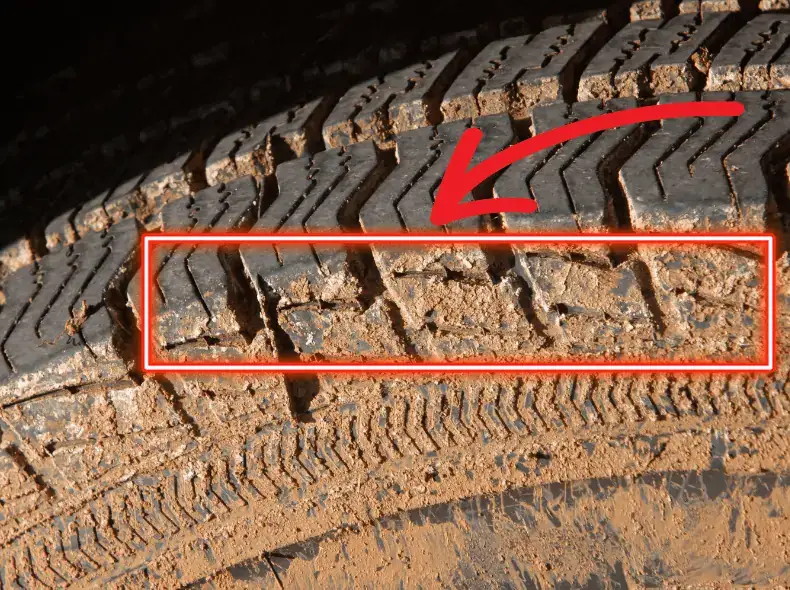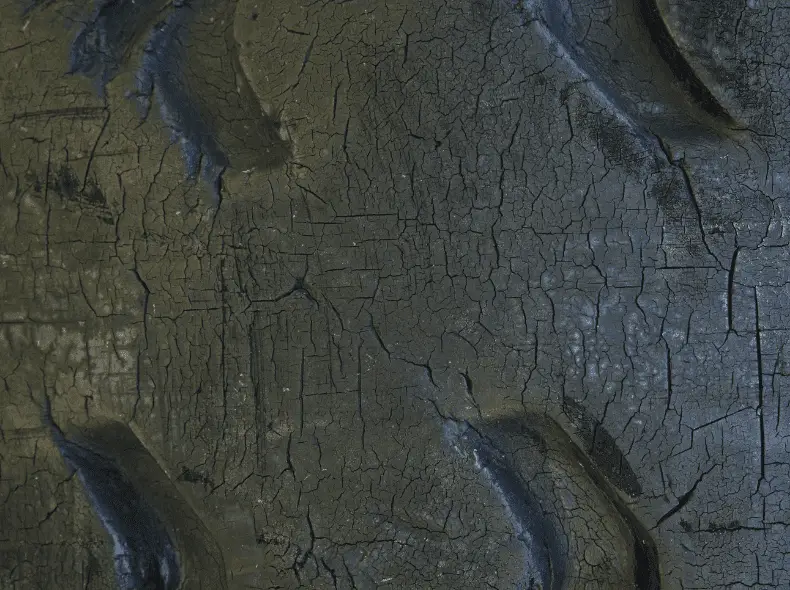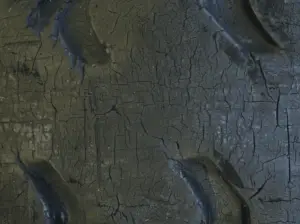Have you noticed tiny cracks appearing in your tire sidewalls? These cracks can be a sign that your tires are experiencing dry rot caused by the sun’s UV rays, but there are five other issues too.
This article will explain how and why tires crack and identify potential dangerous damage below the tires’ surface.
Your tires likely show cracks for more than one of the reasons listed below. As you will see, many of the reasons listed are things that most of us neglect or fail to do with our tires.
Old Tires Do Crack
When a tire has cracks, the most common cause is age-related cracking (also known as dry rot).
If you have noticed cracks in your older tires, it is normal. The best explanation for these cracks is that they are due to age-related degradation of the rubber compound in your tires.
As the rubber ages, it becomes more brittle and dries out more easily. So an older tire will show signs of wear over time and may even develop cracks in its treads or sidewalls.

As a tire ages, it’s more likely to first develop cracks on the tread edge where it meets the side wall than in other areas of the tread surface.
This happens because the tire constantly flexes as it rotates around its axis and rolls over uneven surfaces. These tiny cracks eventually become bigger as the tire flexes again and again until they eventually reach a size where they’re visible.
Sunlight UV Rays
Yes, ultraviolet sunlight has a bad effect on rubber and causes cracks as it causes tires to deteriorate faster.
About 50% of rubber used in tires is made from natural rubber derived from latex tapped from rubber trees. Latex is liquid rubber.
Rubber contains carbon, hydrogen, and oxygen atoms and many kinds of molecules with different structures. This enables it to be made into various products, including tires.
The thing is, Ultraviolet rays break down these molecules over time by breaking bonds between them (called photodegradation).
This breakdown results in changes in physical properties such as reduced elasticity and increased brittleness which can lead to cracking or tearing.
Tire makers add protective chemicals during manufacturing. However, these chemicals don’t always protect against prolonged UV damage.
Chemicals
Chemicals cause cracks in your tire. The chemicals can be found in gasoline, diesel fuel, and other petroleum products. The chemicals can also come from other sources like antifreeze and brake fluid that get onto tires if these systems leak.
Most car cleaning products contain some solvent or alkaline chemical that helps break down dirt on surfaces like car tires or other parts of your vehicle’s exterior.
These chemicals can cause issues with rubber components such as tire sidewalls because they reduce elasticity over time. Take a look at the windshield seal to see how rubber loses its suppleness there too.
Curing shrinkage is a process that occurs when a tire is heated and cooled to form its shape at the factory. However, it’s not normal for this process to cause the tire to crack.
It’s not impossible to get a bad batch of new tires to sneak past quality control.

Poor Tire Storage
If you store your tires in a way that exposes them to heat and sunlight, they may crack over time. Such as in direct view of a south-facing garage window.
The temperature inside the garage can also affect how quickly your tires will crack. If you want to store your tires in a garage, make sure it’s cool enough but not subject to severe cold in winter—between 40 and 70 degrees Fahrenheit.
Try not to stack tires on top of each other. Far better to buy a rack for your garage. This keeps your tires newer for longer.

Excess moisture from the garage floor is bad and can lead to mold growth—and mold is bad news for car tires!
Incorrect Tire Pressure
Either underinflation or overinflation can cause cracks in your car’s tires.
Underinflated tires will result in excessive rubber flexing, which causes stress fractures and, eventually, a crack. When your tire is underinflated, it causes stress on the sidewall and bead.
This creates a lot of tension on the rubber. This tension can cause cracks and other structural problems with your tires that may not be visible.
Overinflated tires are more likely to develop cracks than properly maintained tires.
Tires are made of a rubber compound designed to flex and stretch only within certain parameters.
If a tire is overinflated, it will be too stiff and unable to handle the flexing that occurs when turning or accelerating.
This can cause cracks in the sidewall of the tire.
Overloading
When you overload your car, the weight of the load is transferred to your tires.
Tires are designed to withstand a certain amount of weight and pressure, but when they’re overloaded, that pressure increases to a point where small cracks form in the rubber. These cracks can grow over time and eventually lead to a blowout.
If you do need to carry heavier loads in your car, try not to exceed 80% of the recommended load capacity of your vehicle’s tires.
Is It Bad If Tires Are Cracked?
What you see on the surface of your tire is not the full story. Tire cracks that appear superficial can be quite deep and go through a lot of the rubber.
If you notice over a few weeks that the cracking is becoming more widespread and the cracks deeper, it is time to get your tires inspected at a tire shop and think about replacing them.
Can You Drive On Cracked Tires?
Slight cracking is very common, especially on older tires, so there are many cars on the road with cracked tires. Have a really good look around the rest of your tires. If they are old, they are probably showing other signs of wear and tear and might need replacing anyhow.
The cracks you can see may be the tip of the iceberg and be deeper and more dangerous than you might think. It is always best to get new tires than drive on cracked ones.

Conclusion
Tire cracking is normally caused by more than one issue. Often the reason is simply due to forgetfulness, such as overloading the car or not checking the tire pressures regularly.
Other causes are more difficult to overcome. For instance, if you live in California or Florida, or one of the Southern states, you are more likely to experience higher temperatures and more sunshine in the summer. These factors dry the tire out and start degrading the rubber sooner.


![Minor Dry Rotted Tires [GUIDE] Tire-veins-dry-rot](https://carzaza.com/wp-content/uploads/2023/12/Tire-veins-dry-rot-300x150.png)










